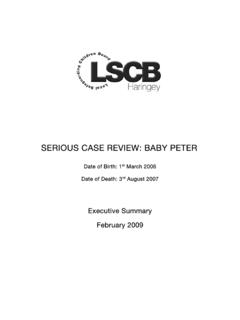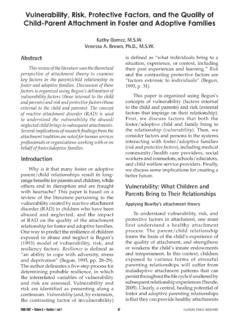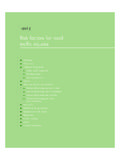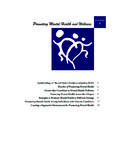Transcription of Understanding Risk Assessment Multi-agency Practice …
1 Understanding Risk Assessment Multi-agency Practice Guidance First edition July 2009. Reviewed July 2010. July 2009; reviewed July 2010 1. This guidance explains the concepts of risk, vulnerability , warning signs and protective factors . To be able to make best use of it you will need an Understanding of child development and the potential impact of child abuse on children and young people (including the long term consequences of abusive experiences). It is also reliant on the complementary skills, knowledge and abilities of all those professionals working with vulnerable children and their families. Section 1 Introduction to Risk Assessment pp. 3 - 5. Section 2 Guidance for Professionals pp. 6 . 17. Examples pp. 18 21. Section 3 What do the words mean? pp. 22 - 28. Appendix A Risk Analysis Grid p. 29. July 2009; reviewed July 2010 2. Section 1. Introduction to Risk Assessment Assessment of Risk An Assessment ' is the purposeful gathering and analysis of available information from which to draw conclusions.
2 In the context of child protection, an Assessment should underpin professional judgements to inform and agree the level and type of intervention that is most appropriate for vulnerable children and young people who may have been harmed or are at risk of harm. Assessment of risk in child protection can only be comprehensive if it considers both past and present in order to identify future risks to a child or young person. It is helpful to consider Assessment of risk on a continuum: the ongoing analysis of a child's known circumstances throughout their life and from original referral through to long term care planning. Interventions should not be delayed until the end of an Assessment , but should be determined according to what is required to ensure a child or young person's safety, taking account of any indications of accelerated risks and warning signs. The type and level of intervention, irrespective of when it is made, should always be proportionate to the evidenced circumstances and risks to the child/ren.
3 Risk Assessment is a pivotal aspect of effective child protection Practice and, for some agencies, is a core responsibility. Good systematic Assessment establishes what may have happened, how this affects the immediate and future safety of the child or young person, places this in a context, and informs what needs to be done. There is no definitive, fail-safe method of predicting risk of harm to children and young people. Involvement of Agencies In all cases that require an Assessment of risk, more than one (and probably several) agencies will be involved in the process. It is imperative that all agencies involved with the child or young person and their parents and carers contribute to the sharing of information. This allows a holistic picture to be developed. When services operate in a joined up way, where all the needs and circumstances of the child are considered, the impact and longer- term outcomes for children and young people are considerably improved.
4 While some professionals may not define their core role as a child protection' one ( professionals who may be working primarily with July 2009; reviewed July 2010 3. the adults in the household), their information and involvement may be crucial in identifying and managing present and future risks to a child or young person. Professionals working with substance misusing parents, for example, can contribute to the Assessment by helping others to recognise the impact of the alcohol or drug use on the individuals, particularly on the adult's ability to parent safely. To optimise the protection of children and young people, agencies must collaborate and undertake Assessment tasks together. Findings should be collated into a comprehensive view of the risks facing the child or young person along with the protective ' factors that exist to minimise risks and maximise their future safety.
5 A collective view of what needs to be done (and when) can then be formed based on all of the information available. Management of Risk As well as contributing to the Assessment of risk, relevant agencies are expected to undertake tasks in the ongoing management of identified risks to the child or young person. The Multi-agency Child Protection Plan (established during the Child Protection Conference and managed by the Multi-agency Core Group) is the mechanism that ensures this for children and young people. Continuous Assessment of risk is an essential component of risk management. Planning should always be proactive, ensuring that measures are in place to protect the child or young person in the event that the Child Protection Plan is not implemented consistently. Contingencies should always be made explicit to all parties (including parents and carers) and should be recorded and updated in the Child Protection Plan.
6 In all cases, parenting capacity should be considered. This involves taking account of parental history as well as assessing the here and now . This means finding out about an adult's own experience of being parented and forming a view as to how they have processed any experiences that may have caused them harm or upset. Prediction of likely future risk of harm should always be based on evidenced risk factors and the identified vulnerabilities associated with the child. These should always be understood alongside identifiable protective factors in respect of the child or their circumstances. Intervention Any intervention considered necessary to improve the circumstances of a child in order to better protect them must always be proportionate action will be inappropriate if it is not proportionate to the presenting evidence. For example, it may not be proportionate to remove a child from the family home if there are risks that are countered by several protective factors (including a July 2009; reviewed July 2010 4.)
7 Supportive and protective extended family) and the child is not considered vulnerable. In addition, the Assessment of risk to children and young people is not purposeful unless it results in identified action. By identifying risks , vulnerabilities, and protective factors , a full and balanced Assessment provides agencies with: An evidential basis on which to proceed and justify decisions and actions A platform for future planning A framework for managing and minimising risks A clear idea of what needs to be done to protect the child (and how). A means against which achievements (or otherwise) can be measured In agreeing intervention, all actions must be clearly and separately identified against each identified risk. In other words, actions must relate directly to individual risks and be designed to directly minimise or remove them. All this must be set out in a systematic way that is achievable, accountable and accessible.
8 Involving children and young people The Assessment of risk to children or young people must, as far as possible, incorporate their views of the risks that they face and their Understanding of what is expected to counter these. Professionals and agencies must consider the right way to capture the views of children and young people in the event, for instance, that they do not want to attend their Child Protection Conference or participate in formal mechanisms to manage risks . Children and young people do not necessarily differentiate between the different components of interventions by professionals or various meetings they may have to attend. However, it is important that their wishes and concerns are routinely considered with them throughout professional involvement. If children and young people do not feel safe, accessible arrangements should always be in place to allow them to say so since young people who are vulnerable may not always be able to communicate this directly or articulate this clearly.
9 In the process of risk Assessment , there should always be an explicit agreement as to how the views of children and young people are to be obtained and how these are to be brought into any Assessment or management planning. July 2009; reviewed July 2010 5. Section 2. Guidance for Professionals This guidance does not provide an exhaustive Assessment tool . Rather, it offers a systematic structure for the collection and analysis of information that aims to support, guide and inform professional judgments about how children and young people at risk of harm get the help they need when they need it. To work well, it relies on an Understanding of child development and the impact of child abuse on children and young people and encourages consideration of the longer-term impact of certain risks , for example, sustained neglect of young children. As well as considering immediate safety provisions that have to be put in place (which are generally the focus of traditional approaches to risk Assessment ), this framework encourages the consideration of the longer-term effects of harm and abusive experiences on children and young people.
10 This will enable immediate and short-term interventions to be both proportionate and appropriate, while allowing for consideration of longer-term outcomes as a result of the abuse or neglect. protective factors only act to protect the child or young person when there is evidence to indicate that risk is reduced by their presence. protective factors alone do not in themselves counteract risk and should not be recorded without qualification. Similarly, listing risk factors without an exploration of what they mean for each child, will not in themselves contribute to a comprehensive Assessment of risk. This framework encourages an analysis of the types of risk that these individual factors (or a culmination of these) may pose for a child, limiting the likelihood of it being used merely as a tool for information gathering. Finally, it is advised NOT to avoid any parts of the Assessment .









